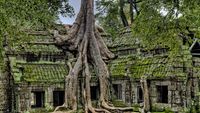CULTURE
The culture of Cambodia is largely based on that of the ancient Khmer Empire. Architecture and iconography, but also dance and literature show the strong Indian influence of that time. For the modern Khmer it serves as a means of national identification and as a figurehead for tourism. The maintenance of the traditional culture in Cambodia is of great importance and is primarily aimed at the temples of Angkor. Music, traditional dances and shadow plays also bear witness to the early development of an independent culture, some of which is still maintained in its original form today and also serves as the basis for new developments. Since 1979 there has been a revival in art. Monuments and stupas are being restored with state funds, rural Buddhist temples (wat) also with local donations. The two art schools in Phnom Penh are open again and are well attended. The National Museum displays many works of art that escaped destruction by the Khmer Rouge.
Khmer literature
Traditional Khmer literature combines entertainment with educational content. The best-known work of early Cambodian literature is the Reamker, a local adaptation of the Indian epic Ramayana. To this day, the Reamker has had a formative effect on new musical, choreographic and theatrical developments. Another text from the Khmer Empire period is the Angkor Wat poem written on the walls of the temple. Religious literature, which is derived from the writings of the rules of Theravada Buddhism, which is prevalent in Southeast Asia, also plays a historical role and guides believers.
Classic Khmer architecture
The roots of classical Khmer architecture can be found in the kingdoms of Funan and Chenla. They showed a strong Indian influence. In Funan, the buildings were mainly made of wood, which is why there are hardly any remains. Chenla adopted and developed Funan's Indianized art and architecture. Brick and stone buildings were erected from the 7th century. Typical relics from this period are prasats, four- or octagonal brick towers with corbelled vaults and a shrine on a pedestal, which consisted of floors that got progressively smaller towards the top.
Sculptures
Few artifacts remain from the Funan period, only four inscriptions on stelae, and some 6th-century artworks, mostly depicting Vishnu with native faces. The style of the statues from Chenla also shows the Indian influence. Stone and bronze were used as materials. The sculptures from early temples at Angkor were relatively stiff and flat, but served as the basis for the later decorated bas-reliefs. Carving lintels was an important art in that early phase. Like the base reliefs, elaborate gable triangles tell stories from the Ramayana and other Indian epics, sometimes also from everyday life. Also in this period stone and bronze were used as materials. The post-Angkorian period is characterized by elaborately designed and decorated wooden statues, of which little survives due to climatic reasons. Today's fine arts are still strongly based on the heyday of the Khmer Empire.
Theatre
The origin of Cambodian theater dates back to the 6th century. Shown are scenes from the Reamker, regional legends, Indian and Theravada Buddhist epics. The theaters use elaborate masks and costumes and are divided into male and female theaters according to the actors. Actors speak and sing, plus a narrator and an orchestra for background music. In the countryside, folk theater and shadow plays are popular entertainment. The content of the shadow play Sbek thom is based on stories from the Reamker. The characters are cut from cowhide, attached to long bamboo poles and often painted. The Royal Theater is also based on the Reamker. Only one modern play is performed in the National Theater, namely “The History of the Country of Cambodia”.
Dance
Cambodia has a long dance tradition. The origins of classical dance lie in the sacred dances of the apsaras, the mythological seductresses of the ancient Khmer empire; possibly they go back to Funan. The high point of classical dance in the Angkor period was based on interpretations of Indian epics, especially the Ramayana - content was about princesses in distress, war heroes, slaves, giants or mystical animals.
The dances are very symbolic and subject to a strict order. They are mostly performed by women, gender differences are represented with different costumes. The dancers are accompanied by an orchestra and a narrative choir. The national dance is the Lamthon, also known as the Apsara dance (Robam Tep Apsara), a style developed in the mid-20th century that is based on the classical Khmer tradition.
Music
Cambodian music is part of the Indonesian-originated "chime" musical culture (use of xylophones and suspended gongs) that includes Burma to the north, Thailand, Laos, the western highlands of Vietnam and the peripheral eastern Philippines. Although some of the musical instruments depicted on Angkor Wat bas-reliefs are still played in folk music today, an Indian influence on Cambodian music is no longer present. Only the ancient one-stringed zither kse diev, which consists of a long staff and a calabash and is pressed against the chest to enhance resonance, is clearly of Indian origin. The Chinese influence is also essentially limited to the design of some instruments. The trapeze-shaped dulcimer khim with 14 three-course strings is derived from the Chinese yangqin, and the long-necked chapey dang veng and its Thai equivalent krajappi are related to some East Asian moon lutes because of their almost circular sound box.
